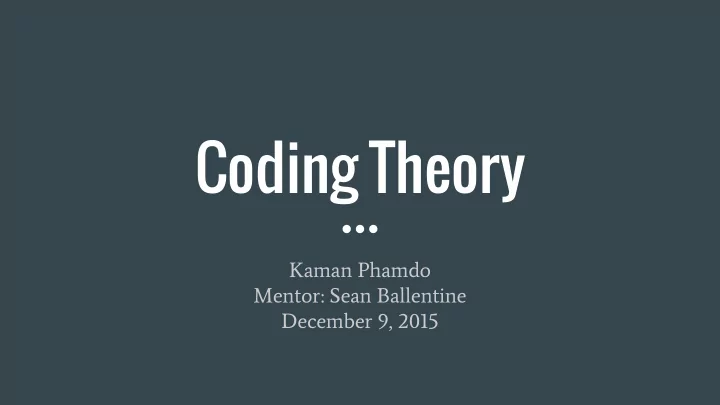

Coding Theory Kaman Phamdo Mentor: Sean Ballentine December 9, 2015
What is a code? ● A code converts information into another representation ● Used for communication through a channel ● How computers communicate ● Encoding ● Decoding
What is a code? message source receiver source encoder channel source decoder NOISE
Example 1 We → 00 love → 01 laugh → 10 math → 11 Suppose we wanted to send the message “ We love math”...
Example 1 We → 00 love → 01 We love math We love laugh laugh → 10 math → 11 00 01 11 channel 00 01 10 no error detected NOISE
Error-Detecting Codes ● ISBN (book numbers) - a 10-digit code used to uniquely identify a book ● Last digit is a check digit used for error detection ● Error-detecting but not error-correcting
Error-Correcting Example We → 00000 love → 00111 laugh → 11001 math → 11110 Suppose we wanted to send the message “ We love math” again, but this time using a longer length for code words.
Error-Correcting Example We → 00000 We love math We love math love → 00111 laugh → 11001 math → 11110 channel 00000 00111 11111 00000 00111 11110 error detected (maximum NOISE likelihood choice is “math”)
Error-Correcting Codes ● Need to detect and correct errors due to noisy channels ● Can be more expensive and less efficient ● We want good error-correcting capabilities and transmission rates ● Coding theory examines transmission of data across noisy channels and recovery of corrupted messages
Hamming Distance ● Let x and y be words of length n over alphabet A . The Hamming distance d(x,y) is the number of places at which x and y differ. ● We can define a minimum Hamming distance for a code ● Larger minimum distance = better error-correcting capability
Linear Codes ● A linear code is an error-correcting code in which each linear combination of codewords are also in the coding alphabet ● Linear codes are vector spaces ● Easier to encode and decode ● Example: A = {000, 001, 010, 011}
Encoding Linear Codes ● Let C be a binary linear code with basis {r 1 . . . r k } ● C can represent 2 k pieces of information (words) ● Any codeword u can be written uniquely as: u 1 r 1 + . . . + u k r k ● The process of representing these elements is called encoding
Decoding Linear Codes ● For non-linear codes, decoding can require exponential computing ● This is why we want linear codes to use in practice ● Nearest neighbor decoding: simple algorithm for decoding linear codes
The main coding theory problem ● Three parameters ○ d - Minimum (hamming) distance ○ n - Length of code words ○ M - Size of coding alphabet ● Given a fixed n and d , what is the largest possible size M that a code can achieve? ● We also examined fixing the other two parameters
Hamming Ball ● For alphabet A, a ball of radius r and center u is the set of vectors in A that have a distance ≤ r from center u . ● The size of a ball of radius r and vectors of length n is given by: (for a binary code)
Our Approach ● Used Python to create computational algorithm ● Created a list to hold our optimal code and added 0 vector ● Generated a code that included each possible vector of at least distance d ● Continued until we had every possibility ● Kept track of best choice
More on Coding Theory ● Other possible paths: ○ Nonlinear codes ○ Nonbinary codes ● Coding Theory: A First Course - San Ling, Chaoping Xing
Recommend
More recommend